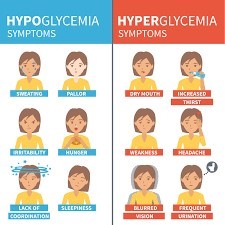A nurse is providing teaching to a client who has a new diagnosis of type 1 diabetes mellitus. The nurse should instruct the client to monitor for which of the following findings as a manifestation of hypoglycemia?
Irritability
Increased urination
Vomiting
Facial flushing
The Correct Answer is A
Irritability.

The rationale for each choice is as follows:
- A. Irritability: Correct. Irritability is one of the signs of hypoglycemia, which occurs when blood glucose levels fall below 70 mg/dL (3.9 mmol/L). Other signs include shakiness, sweating, hunger, headache, confusion, and blurred vision.
- B. Increased urination: Incorrect. Increased urination is one of the signs of hyperglycemia, which occurs when blood glucose levels rise above 180 mg/dL (10 mmol/L). Other signs include thirst, dry mouth, fatigue, nausea, and fruity breath odor.
- C. Vomiting: Incorrect. Vomiting is not a specific sign of hypoglycemia or hyperglycemia, but it can occur as a complication of either condition if left untreated or poorly managed.
- D.Facial flushing: Incorrect. Facial flushing is not a sign of hypoglycemia or hyperglycemia, but it can occur as a side effect of some medications used to treat diabetes, such as niacin or rosiglitazone.
Nursing Test Bank
Naxlex Comprehensive Predictor Exams
Related Questions
Correct Answer is B
Explanation
A is incorrect because documenting client tasks upon completion is an appropriate action by the newly licensed nurse that demonstrates accuracy and timeliness of documentation.
B is correct because starting a task then determining what supplies are needed is an inappropriate action by the newly licensed nurse that indicates poor planning and organization skills.
C is incorrect because completing a client assessment while infusing an IV antibiotic over 30 min is an appropriate action by the newly licensed nurse that demonstrates efficient use of time and multitasking ability.
D is incorrect because returning to the nurses' station after completing several tasks in the same location is an appropriate action by the newly licensed nurse that demonstrates effective prioritization and delegation skills.
Correct Answer is B
Explanation
A. Hypoxemia is a condition of low oxygen levels in the blood. PEEP can actually improve oxygenation by preventing alveolar collapse and increasing functional residual capacity.
B. Tension pneumothorax is a life-threatening condition of air accumulation in the pleural space that causes increased intrathoracic pressure and compresses the lungs, heart, and great vessels. PEEP can increase the risk of tension pneumothorax by creating excessive positive pressure in the airways and alveoli.
C. Malignant hypertension is a severe form of high blood pressure that can cause organ damage and stroke. PEEP can cause a transient increase in blood pressure due to increased intrathoracic pressure, but it does not cause malignant hypertension.
D. Atelectasis is a condition of partial or complete lung collapse due to alveolar collapse or obstruction. PEEP can prevent or treat atelectasis by maintaining positive pressure in the airways and alveoli.
Whether you are a student looking to ace your exams or a practicing nurse seeking to enhance your expertise , our nursing education contents will empower you with the confidence and competence to make a difference in the lives of patients and become a respected leader in the healthcare field.
Visit Naxlex, invest in your future and unlock endless possibilities with our unparalleled nursing education contents today
Report Wrong Answer on the Current Question
Do you disagree with the answer? If yes, what is your expected answer? Explain.
Kindly be descriptive with the issue you are facing.
